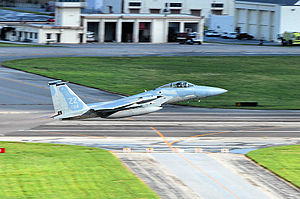Kadena Air Force Base
| Kadena Air Base 嘉手納飛行場 Kadena Hikōjō |
|
|---|---|
| Part of Pacific Air Forces (PACAF) | |
| Located near: Kadena, Okinawa, Japan | |

A 44th Fighter Squadron F-15C Eagle takes off at Kadena Air Base, Japan
|
|
| Coordinates | 26°21′06″N 127°46′10″E / 26.35167°N 127.76944°ECoordinates: 26°21′06″N 127°46′10″E / 26.35167°N 127.76944°E |
| Site information | |
| Controlled by |
|
| Site history | |
| Built | 1945 |
| In use | 1945 – present |
| Garrison information | |
| Garrison |
 18th Wing (USAF) |
| Kadena Air Base | |||||||||||||||
|---|---|---|---|---|---|---|---|---|---|---|---|---|---|---|---|
| Summary | |||||||||||||||
| Operator | USAF | ||||||||||||||
| Elevation AMSL | 143 ft / 44 m | ||||||||||||||
| Coordinates | 26°21′20″N 127°46′03″E / 26.35556°N 127.76750°E | ||||||||||||||
| Website | www.kadena.af.mil | ||||||||||||||
| Map | |||||||||||||||
| Location in Japan | |||||||||||||||
| Runways | |||||||||||||||
|
|||||||||||||||
Kadena Air Base (嘉手納飛行場 Kadena Hikōjō), (IATA: DNA, ICAO: RODN) is a United States Air Force base in the towns of Kadena and Chatan and the city of Okinawa, in Okinawa Prefecture, Japan. Kadena Air Base is home to the USAF's 18th Wing, the 353d Special Operations Group, reconnaissance units, 1st Battalion, 1st Air Defense Artillery, and a variety of associated units. Over 20,000 American servicemembers, family members, and Japanese employees live or work aboard Kadena Air Base.
Kadena Air Base's history dates back to just before the 1 April 1945, Battle of Okinawa, when a local construction firm completed a small airfield named Yara Hikojo near the island's village of Kadena. The airfield, used by Imperial Japanese warplanes, was one of the first targets of the Tenth United States Army 7th Infantry Division. The United States seized it from the Japanese.
What the Americans captured was a 4,600 feet (1,400 m) strip of badly-damaged coral runway. Army engineers from the 13th Combat Engineer Battalion, 7th U.S. Infantry Division quickly made repairs and, by nightfall the same day, the runway could accept emergency landings. Eight days later, and after some 6 inches (150 mm) of coral were added, the airfield was declared operational and put into immediate service by artillery spotting aircraft when the runway became serviceable on 6 April. Additional construction was performed by the 807th Engineering Aviation Battalion to improve the airfield for USAAF fighter and bomber use with fuel tank farms, a new 6,500 feet (2,000 m) bituminous runway, and a 7,500 feet (2,300 m) runway for bomber aircraft by August.
...
Wikipedia


